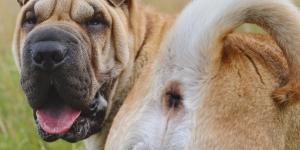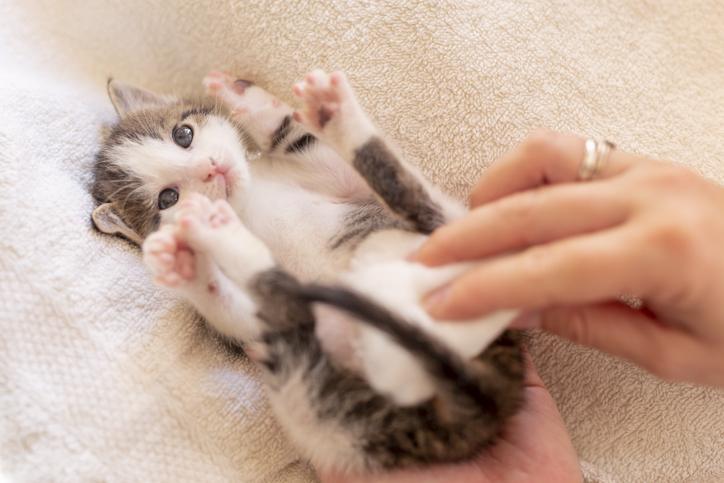Rectal Prolapse in Cats



See files for Cats
Rectal prolapse is a serious condition which can develop from various underlying causes. It is a condition wherein the rectal walls move past the anus to become outside the body. Anal irritation may develop into a full prolapse in certain cases, the cause of which can be difficult to determine. We may be first alerted to a rectal prolapse by the excessive licking of the perianal area by the cat. This could be before the prolapse occurs since irritation can begin in the area beforehand. Veterinary consultation is essential to treat this problem as it is not something we can treat at home.
In this AnimalWised article, we discuss everything you need to know about rectal prolapse in cats, focusing on the causes, treatment and surgery options available.
What is a rectal prolapse in cats?
A cat's anus may become inflamed for various reasons. For example, diarrhea increases the amount of bowel movements and requires the cat to produce more effort when defecating. The result is an irritation to the anal area. The symptoms of this irritation include redness and swelling. It is important to recognize that an inflamed anus is not the same as a rectal prolapse, although it is possible the former is a precursor to the latter.
A rectal prolapse means the tissue of the rectum which should be inside the body passes the threshold of the anus and become externalized. Internal tissue is different to external tissue. The mucosa of the gastrointestinal wall is structured in such a way that it absorbs nutrients and other material which passes through it. Out of necessity, it is very sensitive and easily damaged. If this becomes externalized, it is not only very painful for the animal, but it can lead to infection, trauma and other damage which affects the overall well-being of the cat.
An inflamed anus does not always lead to a rectal prolapse. It will depend on several factors, including the underlying cause, the progression of the problem and whether any effective treatment has been implemented.
Types and symptoms of rectal prolapse in cats
Rectal prolapse occurs to different degrees depending on the severity of the situation. These degrees are so significant they have been given individual terminologies. They are:
- Mucosal prolapse: also known as an incomplete prolapse, this is when the mucosal walls of the rectum protrude outside of the anus, but no further. Again, this can develop into a more severe problem without appropriate treatment. The shape looks different as the mucosal walls are folded over when they protrude.
- Complete rectal prolapse: as the name suggests, this is when the entire rectum is externalized from the anus. As you can see in the photograph below, the rectum is in an almost cylindrical shape and is red in color.
- Internal rectal intussusception: this is when the internal gastrointestinal tissue of the rectum folds into itself, sometimes referred to as ‘telescoping’. It may be asymptomatic since the prolapse occurs inside the body, but you may see similar symptoms as other types of rectal prolapse.
In addition to seeing the actual protrusion of the rectum through the anus, it is likely you will see other concurrent symptoms of a rectal prolapse. These include behavioral changes due to the condition:
- Increased effort when defecating
- Oddly shaped stools
- Evident pain including vocalization during defecation
- Excessive licking of the anal area
- Apathy and lethargy
- Loss of appetite
Take a look at our related article to understand other possible reasons why a cat keeps licking her private area.

Causes of rectal prolapse in cats
The true causes of rectal prolapse are relatively unknown. The main reason for its occurrence is believed to be overexertion during defecation. This needs to be considerable and occur over an extensive period as it takes time for the rectal muscles to weaken.
Since overexertion is believed to be a cause, severe constipation, diarrhea and anorectal obstruction (potentially caused by a foreign body) are all possible contributing factors. It is also possible the cat has a problem urinating and puts more stress on the rectum in the process of trying to urinate. Labor can weaken certain muscles and make a rectal prolapse more likely. Mor common in senior cats, it is possible rectal tumors can lead to rectal prolapse.
It is also important to distinguish between rectal prolapse and other problems related to the perianal area. Strictly speaking, cats do not get hemorrhoids. This is a condition humans get which can look similar to an incomplete prolapse. However, they can have anal gland problems which cause swelling just next to the anus. This is something the veterinarian will need to determine and be treated accordingly.
Rectal prolapse in kittens
We need to highlight rectal prolapse in kittens as young cats are more likely to suffer from diarrhea. The reason for this is an underdeveloped immune system and related vulnerability to disease and parasitical infestation. Parasites can affect the gastrointestinal system in various ways.
Rectal prolapse is most common in kittens younger than 6 months of age. Frequent evacuation can cause anal irritation and, in the most severe cases, a prolapse is possible. Treatment of rectal prolapse in kittens is similar to that of adult cats. However, since they are more vulnerable, veterinary assistance is even more important. The clinical picture can degrade rapidly and they may not have the strength to recover.
Our guide on how to care for kittens will help you to avoid problems such as rectal prolapse in cats.

Treatment for rectal prolapse in cats
Milder cases of rectal prolapse usually resolve themselves with treatment of the underlying cause. Although the swelling may be mild, antiparasitic drugs and antibiotics are usually required. Even with less severe cases, it is important to take the cat to the veterinarian. The prolapse may worsen if the underlying cause is not treated. Direct and swift intervention is the best way to achieve a good prognosis.
Medications alone are considered a conservative treatment and will not solve all rectal prolapses. This is partly because the prolapsed tissue needs to be returned to its original position. To return the prolapsed tissue to its original position, surgical intervention is usually required. This is especially the case with complete rectal prolapse. The operation will be undertaken with the cat under anesthetic.
Swift medical intervention is particularly important with complete rectal prolapse of a cat. If the internal tissue is outside of the body for too long, it can become necrotic (dead). In these cases, part of the surgery will involve removing the necrotic tissue, before putting the rectum back in the body. In caes of recurrent rectal prolapse, it is possible a laparoscopic colpopexy may be used as a quicker and more effective surgical method[1].
After the operation, it is common for the veterinarian to recommend a diet rich in fiber. This will improve stool consistency and intestinal transit. They may also prescribe products to soften them and medication against pain and irritation. As a preventive, it is important the cat is dewormed internally on a regular basis. If your cat develops recurrent rectal prolapse, it is very important all aspects of their dietary health should be monitored and they behavior keenly observed.
Discover the causes and symptoms of intestinal blockage in cats with our related article.
Anal prolapse in cats
Cat anal prolapse and rectal prolapse are similar conditions in felines, but there are certain determining differences. An anal prolapse in cats involves the inner lining of the anus protruding outside of the body. This is a small amount of tissue around the anus and is considered a less serious condition.
When a rectal prolapse occurs, it will always also include this anal tissue. This means a rectal prolapse won't occur without an anal prolapse. However, an anal prolapse can occur without a rectal prolapse.
While it may look like it, it may not be that an anal prolapse has occurred. There are various causes of a cat having a swollen anus that you may need to distinguish. For this reason, veterinary consultation is recommended.

Can you treat rectal prolapse at home?
You may have read about possible homemade or natural treatments for rectal prolapse in dogs. Some claim that products like aloe vera will help soothe the area and treat the condition. Such treatments are ineffective. There is at least some evidence to suggest it can also be toxic[2].
The problem is that even mild cases can worsen with improper treatment. It is essential we go to the veterinarian to ensure the right course of action is taken. A poorly treated or neglected rectal prolapse can result in necrosis or infection, putting the overall well-being of the cat at risk. Between observing the prolapse and taking the cat to a veterinarian, we should cover the area in gauze soaked in saline solution.
We will also need to monitor the cat so they do not worsen the situation by licking or scratching at it. This may require the use of an Elizabethan collar, something the vet may also give after surgery.

This article is purely informative. AnimalWised does not have the authority to prescribe any veterinary treatment or create a diagnosis. We invite you to take your pet to the veterinarian if they are suffering from any condition or pain.
If you want to read similar articles to Rectal Prolapse in Cats, we recommend you visit our Other health problems category.
1. Secchi, P., et al. (2012). Laparoscopic-assisted Incisional Colopexy by Two Portals Access in a Domestic Cat with Recurrent Rectal Prolapse. Journal of Feline Medicine and Surgery, 14(2), 169-170.
https://journals.sagepub.com/doi/full/10.1177/1098612X11429230
2. Pressman, P., Clemens, R., & Hayes, A. W. (2019). Aloe Vera at the Frontier of Glycobiology and Integrative Medicine: Health Implications of an Ancient Plant. SAGE Open Medicine, 7.
https://journals.sagepub.com/doi/10.1177/2050312119875921
1. Nelson, R., & Couto, C. G. (2019). Small Animal Internal Medicine. Elsevier.
https://www.elsevier.com/books/small-animal-internal-medicine/nelson/978-0-323-57014-5








